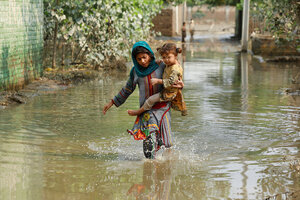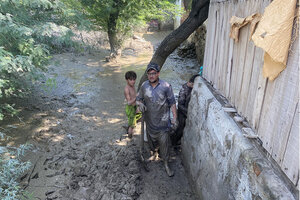‘I’m still alive, but that’s it’: Pakistan floods test resilience

A girl carries her sibling as she walks through floodwaters during the monsoon season in Nowshera, Pakistan, on Sept. 4, 2022. The city sits on the banks of the River Kabul, which surged in the early hours of Aug. 27.
Fayaz Aziz/Reuters
Nowshera, Pakistan
Outside the entrance to his flood-damaged house, 18-year-old engineering student Rehanullah Khan rests against the trunk of a winding tree. He is dressed in a traditional cotton kurta shalwar, tunic and trousers, which might once have been gray or blue but are now completely brown, caked with layers of mud.
For the past two days, he and his family have been working round the clock to shovel all the mud and water out of their house, struck by the recent floods. After taking a moment to catch his breath, he picks up his shovel and gets back to work, clearing a path from the road to his door.
“No one has come to help us, not from the government or anywhere else,” he says. “Officials from the administration say that if they come down here, they might slip in the mud and break their bones.”
Why We Wrote This
Catastrophic flooding throughout Pakistan is demanding more than resilience; it’s forcing communities to make difficult decisions about what can be saved and where to direct aid.
In some of the spots that Mr. Khan has not yet cleared, the mud lies 3 feet deep. His cousin, Salman, who lives in the same house, says that the family has lost most of their belongings in the flood. “We had to get out of here in a hurry and we were only able to take a couple of things,” he says. “Everything else got taken by the water. I swear it’s been four or five days since any of us have slept. We spend all day and night trying to clean up the mess.”
The cousins live in a poverty-stricken neighborhood called Sultanabad in the city of Nowshera on the banks of the River Kabul, which surged in the early hours of Aug. 27. As in other parts of the country, the record flooding has tested the resilience of local families as well as the district administration, which has been scrambling to contain the crisis and evacuate victims to higher ground.
“We had a single objective in our minds,” says Deputy Commissioner Reza Ozgen, the top civil servant in the district. “When I assembled my team on the day of the flood, I told them that we can’t control the damages that will take place, but what we can do is ensure that no life is lost and that’s what we were successful in.”
That is a significant achievement; more than 1,200 people – almost one-third of them children – have died since the monsoon began at the end of June. Sherry Rehman, the government’s climate change minister, calls the flooding a crisis of “unimaginable” proportions imposed by “other countries that have gotten rich on the back of unchecked fossil fuel consumption.”
Pakistan is especially vulnerable, she says, “because we are on the front lines … [with] the largest number of glaciers in the world, as well as the hottest cities on the planet.”
Lessons from 2010
The last catastrophic floods in Pakistan occurred in 2010, when over 20 million people lost livestock, farmland, or houses. Early indications suggest that this monsoon is likely to be even more devastating: The National Disaster Management Authority calculates that over 33 million people are likely to be affected.
In Nowshera, officials estimate that more than 8,000 houses have been partially or fully damaged – a number that is expected to rise significantly as more reports come in from the field. Gul Mohammad, who used to make a living pushing an ice-cream cart, is one of many whose homes have been left uninhabitable. He is now sleeping rough on a straw bed in the road. “Everything is finished. I’ve lost everything,” he says. “Praise be to Allah I’m still alive – but that’s it.”
Local officials maintain, however, that the damage could have been far greater had successive governments not learned lessons from the floods of 2010. Assistant Commissioner Ummar Awais Kiani points to the flood protection wall built by the government along the River Kabul as evidence that progress had been made in disaster preparedness.
“If this protection wall hadn’t been built, we would have had complete devastation. The entire district would have been flooded,” he says.
At the same time, the local government has also come under criticism. Senior civil servant Mr. Ozgen argues that riverbed encroachment, by illegally constructed buildings, has narrowed the flow of water in areas like Nowshera and increased the risk of flooding.
“Over time our institutions have become weak,” he says. “There are a lot of loopholes where building plans are approved, and we know why they’re approved – through somebody’s influence or under the table … you know … and eventually the country has to pay the price for that.”
Humanitarian response
It has also been a challenge to coordinate the humanitarian response, not least because Pakistan is in the middle of a cost-of-living crisis that has left vast swaths of the population struggling to sustain themselves. “It’s not that the aid hasn’t come,” says Mr. Mohammad. “It’s just that there are so many people who have turned up from far and wide, setting up tents and pretending to be flood victims. They’ve stolen the morsels out of our mouths.”
This has obliged the district administration to change its approach toward distributing aid. “Initially we had 71 relief camps,” says Mr. Ozgen. But “slowly we started finding out that people who were not affected were coming to those camps and taking all the goods,” he explains. “Now we’re operating only four [camps] and those are the ones where the real affectees are staying.”
The change of strategy has involved encouraging as many of the flood victims as possible to return to their own homes, whose sorry condition is evidence of their inhabitants’ need. “As long as they go back, we will be able to provide rations to their homes,” says Mr. Ozgen. “Secondly, they will help our administration and the municipal services to clear the streets and clean the houses.”
But some relief workers challenge this approach. “The local official has told me to shift people back home, but I don’t know how I’m supposed to do that,” complains Muhammad Ismail, who runs a relief camp in a Nowshera school. The camp’s residents are refusing to leave, he says, “and even if I was able to evict them by force, where will these people go? Their houses are knee deep in water and mud.”
But the authorities have suspended relief aid to Mr. Ismail’s camp, and he says he cannot continue to feed the 50 children under his care from his own funds. “Adults can go hungry but what are we to do about these children?” he asks. “How are they supposed to get by without any assistance?”
Qurut-ul-ain Wazir, the official tasked with coordinating the government’s relief efforts, argues that given the scale of the disaster her team will never be able to satisfy all the needs; she is appealing for help from private groups.
“Because this is an emergency, we cannot achieve 100% success,” she says. “We might be able to solve 60 or 70% of the problems, but the remaining 30% has to come from the nongovernmental sector.”


